Budgie Enclosures: Optimal Habitats for Your Birds
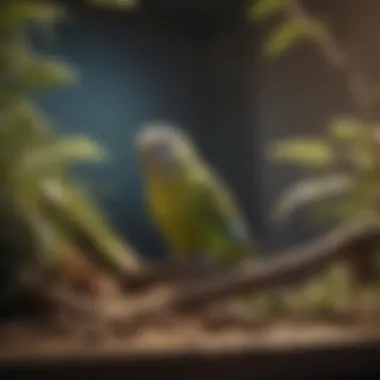
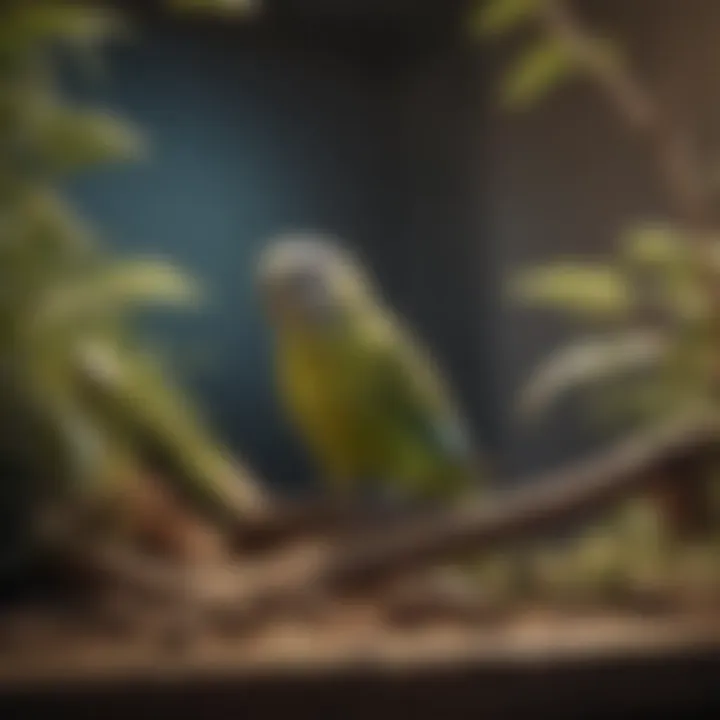
Intro
Creating an optimal budgie enclosure requires more than just a physical structure. It necessitates an understanding of the needs and behaviors of these vibrant creatures. This article outlines various aspects of budgie enclosures, offering insights into the design, size, and essential features that directly contribute to the well-being of your feathered companions.
Bird owners, whether novice or experienced, will find valuable information to create a nurturing environment for their pets. Addressing care, nutrition, and social needs will enhance the happiness of your budgies, ensuring they thrive both physically and emotionally. These insights are critical for developing an enriching habitat that supports healthy interaction and behavior.
Let's delve into critical factors that contribute to a suitable living space for budgies, initiating our discussion with essential care tips.
Understanding Budgies
Understanding budgies is crucial for anyone considering these charming birds as companions. Grasping their needs, characteristics, and behaviors helps create a suitable environment. This understanding influences everything from diet to housing arrangements, ultimately impacting their overall well-being. A well-informed budgie owner is more likely to experience the joys of a healthy and interactive pet.
Basic Characteristics
Budgies, also known as budgerigars, are small, colorful parrots native to Australia. Their vibrant plumage and playful demeanor make them popular among pet bird enthusiasts. Adult budgies typically measure about 7 to 8 inches in length, with most of their body weight concentrated around the chest. Despite their small size, they have an impressive life expectancy, often living between 5 to 15 years with proper care.
Apart from physical traits, it's essential to note that budgies are social creatures. They thrive in environments where they can interact with their human caretakers and, ideally, other birds. Budgies come in various color mutations, including green, blue, and yellow. Each color variation has its own charm, and this diversity adds to their appeal as pets.
Behavioral Traits
Budgies exhibit a range of behaviors that highlight their intelligence and sociability. They are naturally curious and enjoy exploring their surroundings. Playfulness is a hallmark of their personality, as they often engage in games, especially if toys are available to stimulate their minds. In addition to being playful, budgies are vocal birds. They communicate through chirps and chatter, and each bird can have unique vocal characteristics.
Another critical aspect of their behavior is their need for companionship. Budgies can become lonely and stressed if left alone for extended periods. Consequently, keeping more than one budgie is often recommended to ensure they have social interactions. Providing opportunities for mental and physical enrichment is vital for their happiness, which makes understanding their behavior fundamental when setting up their enclosure.
An optimal habitat considers both physical and mental well-being, as an understanding of budgie behavior is essential in crafting such a space.
In summary, understanding these fundamental characteristics and behaviors allows budgie enthusiasts to create an environment that caters to their physical and emotional needs, ensuring they flourish as beloved companions.
The Importance of Enclosure
Creating the right enclosure for a budgie is essential for its overall health and happiness. An enclosure serves not just as a physical barrier, but as a multi-faceted environment that can significantly impact a budgie's life experience. This section delves into the critical elements that define the importance of proper enclosure setups, focusing on well-being and habitat enrichment.
Impact on Well-Being
A well-designed enclosure can have profound effects on the physical and mental health of budgies. Proper space allows for movement, exercise, and social interaction, which are key aspects of a budgie's daily life.
- Physical Health: Adequate space prevents obesity, which is a common issue in captive birds. Budgies that have room to move and exercise are less prone to health complications.
- Social Interaction: Budgies are naturally social creatures. An enclosure that allows for interaction with other budgies can reduce stress and promote healthy behaviors.
- Stress Reduction: A secure and spacious environment minimizes stress, which is vital for a bird's mental health.
Research indicates that birds housed in cramped or poorly designed enclosures may exhibit signs of anxiety and depression. Regularly observing budgies within their enclosures reveals how much space and stimulation matter for their thriving.
"An appropriately sized and designed enclosure is not just a luxury for budgies; it's a necessity that contributes to their long-term well-being."
Habitat Enrichment
Habitat enrichment refers to providing a stimulating environment that encourages natural behaviors in budgies. This concept is vital for not only keeping budgies engaged but also ensuring they are psychologically healthy. Here are several ways to enhance the standard enclosure:
- Variety of Perches: Different heights and materials help exercise their feet and keep them active.
- Toys and Activity Stations: Rotate toys regularly to prevent boredom. Enrichment toys can include swings, ladders, and foraging devices.
- Natural Elements: Incorporating branches, leaves, and safe plants can create a more natural habitat, beneficial for exploration and play.
Habitat enrichment fosters an engaging environment where budgies can display their natural behaviors, such as climbing, flying, and foraging. This not only boosts their physical activity but also promotes cognitive engagement, leading to healthier and more content birds.
Types of Enclosures
Understanding the different types of enclosures for budgies is fundamental for their health and happiness. The type of enclosure you choose not only influences the living conditions of your budgies but also affects their behavior, well-being, and the ease of care for their environment. Various options exist, each with unique features, benefits, and considerations for budgie owners. This section explores cages, flight aviaries, and the differences between indoor and outdoor enclosures.
Cages
Cages are the most common type of enclosure for budgies and come in various shapes and sizes. A few key factors should be considered when selecting a cage. The size of the cage should be ample to allow freedom of movement and flying short distances. A cage that is too small can lead to stress and health issues.
Ideal cages have horizontal bars for climbing, which encourages exercise. Wire spacing is another critical element; it should be narrow enough to prevent escapes or injuries. A safe rule is to look for spacing that does not allow a budgie's head to fit through. In terms of cleaning, cages with removable trays can greatly simplify maintenance, ensuring a healthy environment.
Advantages of choosing a cage include:
- Easier cleaning: Cages usually have designed for quick access.
- Portability: Many cages are lightweight and easy to move.
- Variety: Options range from simple to elaborate designs.
However, be mindful of any non-toxic materials used in the construction. Avoid cages containing harmful chemicals or sharp edges that can injure your pets.
Flight Aviaries
Flight aviaries represent a more extensive habitat option, catering specifically to a budgie's natural desire to fly and explore. These enclosures can vary from large indoor setups to spacious outdoor aviaries. Flight aviaries provide more room for exercise, reducing stress and promoting better physical health.
The design should prioritize vertical space since budgies like to fly upwards. Tall aviaries allow for more natural behaviors. Including branches of varying diameters serves to stimulate their exercise and help with natural beak and claw maintenance. Flight aviaries also allow for social interaction when keeping multiple budgies.
Some benefits of flight aviaries include:
- Enhanced well-being: The environment allows for more natural behaviors.
- Increased social interaction: Perfect for multiple pet birds.
- Longer lifespan: A healthy habitat can contribute to longevity.
Despite these advantages, setting up a flight aviary might require more initial investment and space. Additionally, ensure suitable weather conditions for outdoor aviaries, accounting for temperature variations and protection during inclement weather.
Indoor vs. Outdoor Enclosures
When deciding between indoor and outdoor enclosures, owners must assess their living environment and the specific needs of their budgies. Indoor enclosures provide a controlled climate and protection from predators. They are also easier to monitor for cleanliness and ensure the birds' safety from environmental hazards.


On the other hand, outdoor enclosures can benefit budgies by offering natural sunlight and fresh air, which can be invigorating for their health. Natural elements like branches, plants, and natural light can significantly improve a budgie's habitat. However, outdoor environments require strict monitoring for temperature changes and threats from predators like cats or birds of prey.
Both indoor and outdoor enclosures have their pros and cons. Consider the following:
- Indoor enclosures offer:
- Outdoor enclosures provide:
- Stable temperatures
- Ease of monitoring
- Safety from wildlife
- Natural sunlight
- Fresh air
- Opportunity for natural behaviors
Choosing the appropriate type of enclosure will lay the foundation for a thriving environment. Always factor in your living situation, budgie habits, and personal preferences when making your decision.
Optimal Size and Dimensions
Understanding the optimal size and dimensions for budgie enclosures is crucial for promoting the well-being of these small, intelligent birds. Their natural instincts drive them to fly, move, and explore. Enclosures that do not meet their spatial needs can hinder their overall health and behavior. Therefore, it is essential to carefully consider space requirements to create a habitat that fosters physical health and mental stimulation.
Minimum Space Requirements
When selecting an enclosure for your budgie, the minimum space requirements should be a primary consideration. According to various bird care guidelines, a single budgie should have a cage that is at least 18 inches long, 18 inches deep, and 24 inches high. This allows enough room for the bird to stretch its wings and move around comfortably.
However, larger is always better. Budgies thrive when they have extra space to fly short distances. This promotes activity and reduces stress. Additionally, a larger cage allows for a variety of perches, toys, and food dispensers, which can enhance physical and mental engagement.
It is also wise to remember that larger enclosures are easier to maintain. The additional space helps prevent the accumulation of waste and ensures more comfortable living conditions.
Dimensions for Multiple Budgies
If you are considering housing multiple budgies together, the size of the enclosure becomes even more important. Each additional budgie requires approximately 4 cubic feet of space. For example, an enclosure suitable for two budgies should ideally measure at least 24 inches long, 18 inches deep, and 30 inches high.
Designing an environment with sufficient space encourages social interaction among your budgies while allowing them to establish personal territory. It is also beneficial to provide multiple levels within the cage. Vertical space is just as important as horizontal space. Budgies enjoy flying upwards and explore different heights, which can significantly enhance their quality of life.
Summary: Ensure that your budgies have adequate space for their needs. The minimum and recommended dimensions should align with the number of birds, encouraging a healthy environment that allows for movement, play, and interaction.
Material Choices for Enclosures
Material choices for budgie enclosures are pivotal to creating a safe and comfortable habitat for your feathered companions. Selecting appropriate materials affects not only the durability and functionality of the enclosure but also the overall well-being of the budgies. The right materials can prevent accidents and injuries, support hygiene, and enhance the aesthetic of the living space. In this section, we will explore the types of wire materials and the importance of non-toxic coatings.
Types of Wire Material
When considering materials for budgie enclosures, wire is often the primary choice. Various types of wire materials are available, each with distinct characteristics. Here are some commonly used wire materials and their benefits:
- Galvanized Steel: Galvanized steel is a popular choice because it is durable and resistant to corrosion. This ensures longevity, provided that it is not subjected to harsh weather conditions if used outdoors.
- Stainless Steel: Stainless steel is another excellent option. It does not rust and is more resilient to denting and scratching. While more expensive, it is a worthy investment due to its durability.
- Plastic Coated Wire: This type combines wire strength with a layer of plastic, creating a softer feel. However, it's essential to regularly check for wear and tear, as the coating can degrade over time.
The spacing of the wire is equally important. The gaps should be narrow enough to prevent accidental escapes or predation. A spacing of 1/2 inch is typically recommended for budgie enclosures.
Non-Toxic Coatings
Non-toxic coatings are essential when selecting materials for budgie enclosures. Budgies are curious and often nibble on surfaces within their reach. Coatings that contain harmful chemicals can pose serious health risks. Here are some key points regarding non-toxic coatings:
- Safety First: Always choose coatings specifically labeled as non-toxic. Brands that are pet-safe often provide assurance that their products will not harm your birds.
- Types of Coatings: Powder coatings are a popular choice. They provide a durable surface and do not produce harmful fumes. Paints also exist that are labeled as safe, but it is crucial to ensure they are designed specifically for bird environments.
- Maintenance: Non-toxic coatings should be easy to clean and maintain. Regularly inspecting for chips or worn areas can help prevent potential ingestion of harmful materials.
Selecting the right materials for a budgie enclosure is a fundamental aspect of avian care. It ensures safety, comfort, and a healthy living environment for your birds.
Understanding the material choices for budgie enclosures provides a strong foundation for creating an enriching habitat. By being deliberate in your selection, you foster a safe space that supports the physical and mental well-being of your feathered friends.
Essential Features
Understanding the essential features of budgie enclosures is crucial for ensuring the well-being of these vibrant birds. Each component within the habitat plays a significant role in promoting their physical and mental health. When selecting the right features, one must consider the natural behaviors of budgies. This includes their need for perches to rest and play, appropriate food and water dispensers to stay nourished, and toys to stimulate their minds.
Perches and Platform Spaces
Perches are fundamental in any budgie enclosure. They offer birds a place to rest and engage in activities that mimic their natural environment. When selecting perches, it is advised to have a variety of sizes and materials. This encourages exercise and foot health as budgies will have to adapt their grip to different textures. Natural wood perches are often recommended because they provide a safe, durable, and comfortable surface. It is also beneficial to include platforms that allow for additional resting spots. This can help reduce stress among birds and promote social interactions, especially in multi-budgie setups.
Food and Water Dispensers
Proper nutrition is vital for budgies, so the design of food and water dispensers should be carefully considered. Bowls should be shallow enough for easy access yet deep enough to prevent spillage. Stainless steel or ceramic bowls are often preferable due to their durability and ease of cleaning. It is essential to keep food and water fresh, so regular checks on the dispensers are needed. Automatic watering systems can be a great option for those who want to ensure a constant supply of clean water, reducing the risk of dehydration.
Toys and Stimulation
Toys are indispensable for maintaining the mental health of budgies. They provide necessary stimulation that can prevent boredom and behavioral issues. Various forms of toys can be incorporated, such as chew toys, swings, and foraging devices. Chewing is a natural behavior for budgies, so providing safe materials can help keep their beaks healthy. Introducing new toys regularly can also keep them engaged and curious. Careful selection of toys made from non-toxic materials is essential to ensure safety while maximizing fun. Enrichment through such toys enhances their quality of life and contributes to a happier living environment.
Location Considerations
The placement of a budgie enclosure is crucial for the overall health and well-being of these spirited little birds. Choosing the right location not only affects their physical environment but also influences their behavior and emotional state. An appropriate location takes into account light, temperature, noise levels, and social interactions, all of which play pivotal roles in ensuring that budgies thrive in captivity.
Indoor Placement
For indoor placements, it is essential to find a spot that offers natural light without harsh sunlight. Budgies enjoy sunlight as it helps them synthesize Vitamin D, but direct exposure can lead to overheating or stress. Placing their cage near a window may provide necessary light, but it should be ensured that the temperature remains stable.
Budgies are social creatures. Therefore, positioning their enclosure in a common area of the home allows them to engage with family members and feel more included in daily activities. It is advisable to avoid areas that experience high foot traffic or frequent disturbances. Birds can be sensitive to sudden loud noises or abrupt movements, leading to stress.
Moreover, it’s best to keep the cage away from drafts caused by open windows or air conditioning units. Consistency in temperature helps maintain their health, reducing the risk of illness. Taking these considerations into account when placing the cage can create an environment that is both enriching and calming for your budgies.
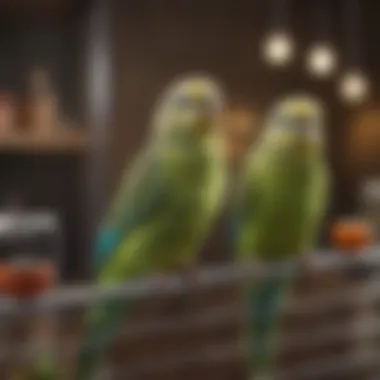
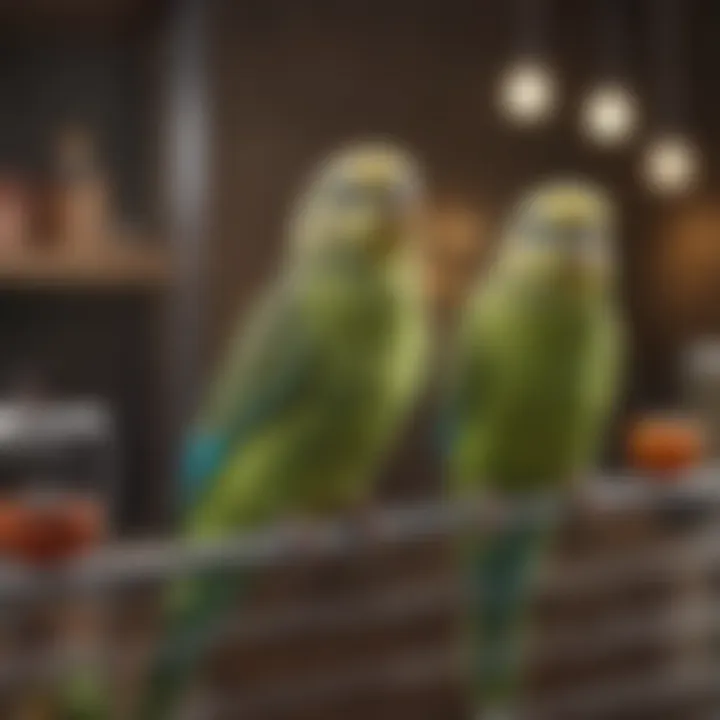
Outdoor Considerations
When contemplating outdoor enclosures, various factors must be addressed for the safety and comfort of your budgies. Outdoor enclosures can provide a fresh air experience and a chance for birds to engage with nature, but they come with distinct risks.
Firstly, ensure that the enclosure is protected from environmental elements like wind, rain, and extreme temperatures. Utilize sturdy materials to build the enclosure that can withstand these conditions. Adding shade is also important to prevent overheating during hot days. An outdoor space should be enclosed securely to ensure robust protection against predators.
Budgies should never be left outdoors unsupervised, as they can easily become targets for cats, hawks, or other animals.
Additionally, consider air quality and pollution. Avoid placing the enclosure near spaces with heavy traffic or industrial areas, as pollutants can harm the birds' respiratory systems. Also, be mindful of plants in the vicinity; some plants can be toxic to birds. Overall, while an outdoor environment can significantly enhance your budgie's quality of life, proper precautions are necessary to create a safe and suitable habitat.
Safety and Security
Ensuring the safety and security of budgies is crucial for their well-being and longevity. These small birds are curious and active, which exposes them to various risks within their enclosures. Without sufficient safety measures, the consequences can be dire, not only for the birds’ physical health but also for their emotional stability. A secure environment allows budgies to explore and socialize while minimizing stress or anxiety levels. This section will explore the numerous aspects related to safety and security in budgie enclosures, focusing on elements like preventing escapes and protecting them from predators.
Preventing Escapes
Budgies have a natural tendency to test the limits of their surroundings. This curiosity can lead them to escape from enclosures. Simple mistakes, such as leaving cage doors ajar or using inadequate locking mechanisms, can have significant consequences. When creating an enclosure, it is essential to choose designs that include secure locking systems designed to withstand their efforts to push or pry open doors.
The following measures can enhance escape prevention:
- Strong Locks: Use locks that are difficult for the birds to manipulate. Consider using sliding bolts or snap closures that require human coordination.
- Tight Fitting Bars: Ensure that the bars or mesh are close together. A gap of more than half an inch can enable even a young budgie to escape.
- Secure Roofs: Consider enclosures with tops. Budgies are adept at flying upward and may escape by soaring out of open-caged spaces.
- Periodic Checks: Regularly inspect the enclosure. Look for weak points or wear and tear that might compromise security.
Taking these steps minimizes the risk of escapes. Not only does this ensure the safety of the birds, but it also aids in providing peace of mind to their owners.
Protection from Predators
Predators pose another significant threat to budgies, especially in outdoor enclosures. Whether it’s a dog, cat, or even a bird of prey, the risk must be mitigated. A secure enclosure not only protects the birds from escape but also serves as a defense against various potential threats.
To protect budgies effectively, consider the following strategies:
- Strong Materials: Use durable materials that can withstand an attack. Wire mesh should be heavy-duty and resistant to bending.
- Heightened Enclosure: Elevate the enclosure off the ground if possible. This makes it more challenging for many predators to reach your birds.
- Overhead Netting: If the enclosure is outside, consider adding overhead netting. This will prevent aerial attacks from larger birds.
- Avoid Ground-Level Placement: Never place the enclosure directly on the ground. This positioning can make it easier for ground predators to access.
By paying attention to potential threats, budgie owners can significantly reduce the chances of their birds facing harm. Ensuring both escape prevention and predator protection creates a secure and healthy environment for these feathered companions.
"A secure habitat is the backbone of a fulfilling life for your budgies, ensuring their happiness and health."
Incorporating these measures not only enhances the security of the enclosure but also cultivates an environment where budgies can thrive, free from unnecessary fear or stress.
Maintaining Cleanliness
Maintaining cleanliness in budgie enclosures is a critical aspect of responsible bird ownership. It contributes directly to the health of your feathered companions and ensures their habitat remains safe and comfortable. Budgies, like all pets, are susceptible to diseases caused by pathogens and bacteria that thrive in dirty environments. By upholding a strict cleaning regimen, pet owners can minimize these risks. Moreover, a clean enclosure fosters a pleasant atmosphere not just for the birds but also for humans who interact with them.
Daily Maintenance Routines
Creating a daily maintenance routine is essential for keeping budgie enclosures in optimal condition. Each day, focus on the following tasks:
- Food and Water: Check the food and water dishes daily. Remove any spoiled food and replace it with fresh items. Ensure the water is clean, and refill it as needed.
- Spot Cleaning: Inspect the bedding and floor of the enclosure. Remove droppings or debris. This simple task can significantly reduce odors and the chance of bacterial growth.
- Toys Inspection: Examine toys and perches for signs of wear and residue. Clean or replace any items that appear dirty or damaged.
Maintaining such routines creates a healthier living space, allowing budgies to thrive. It also establishes a sense of normalcy that both the birds and their owners can rely on.
Deep Cleaning Practices
In addition to daily routines, deep cleaning practices should be conducted regularly, ideally once a week. These practices go beyond spot cleaning and encompass more comprehensive tasks:
- Disassemble the Enclosure: If possible, take apart the cage or aviary. This will allow you to reach all corners and hidden areas where dirt can accumulate.
- Steam Clean or Wash Surfaces: Use a bird-safe disinfectant or a solution of vinegar and water to clean all surfaces. Rinse thoroughly to avoid the risk of harmful residues.
- Clean Perches and Accessories: Submerge perches and other hard accessories in the cleaning solution. Scrub them to remove any buildup. Rinse them well before placing them back.
- Replace Bedding and Liners: If your enclosure has a bottom liner or bedding, make sure to replace them during deep cleaning. This practice helps prevent odor and improves hygiene.
- Inspect for Damage: Check the enclosure for any signs of wear or damage. Ensure all parts are secure and that there are no sharp edges that could harm the birds.
"A clean environment is crucial for preventing disease and ensuring the well-being of your budgies. Never underestimate the impact of hygiene on pet health."
Maintaining cleanliness is not simply a chore; it is a fundamental responsibility of bird ownership. Whether through daily maintenance routines or thorough deep cleaning, pet owners play a significant role in promoting the well-being of their budgies.
Adapting Enclosures for Specific Needs
Adapting enclosures for specific needs is a vital aspect of ensuring the health and comfort of budgies. Every bird is unique, and circumstances such as age, health condition, and personality can significantly influence the type of environment that will suit them best. By modifying enclosures accordingly, owners can enhance the quality of life for their feathered companions. It is crucial to consider the adjustments needed, the benefits they provide, and the overall implications for the birds.
Caring for Elderly Budgies
As budgies age, their activity levels, agility, and overall health may change. Older birds often benefit from enclosures designed for ease of access. This might mean using larger doors or ensuring food and water are easily reachable. Moreover, providing plenty of perches at different heights can help elderly budgies navigate their space without exerting too much energy.
The choice of perches is also important. Soft wooden or natural fiber perches can reduce strain on mature feet and joints, providing a comfortable standing area.
Enrichment is essential but should be tailored to the abilities of older budgies. Toys that are simpler to manipulate can keep them engaged without causing frustration. Additionally, softer toys and quiet areas allow for much-needed rest without stress.
Accommodating Health Issues
When it comes to budgies with specific health issues, adapting enclosures becomes increasingly important. For example, birds with respiratory problems may require better ventilation or air purification systems. Avoiding toxic materials is also crucial in creating a safe space.
If a budgie has limited mobility due to injury or illness, designing a layout that minimizes barriers is advantageous. This may include placing essential items like food, water, and toys closer together and ensuring the substrate is soft and non-slippery to prevent accidents.
Regular monitoring is vital. Owners should keep an eye on how well the enclosure adjustments meet the birds' needs and be ready to make further changes when necessary.
"The health and well-being of budgies are tied closely to the environment they live in. Tailoring enclosures for specific needs can make a significant difference in their quality of life."
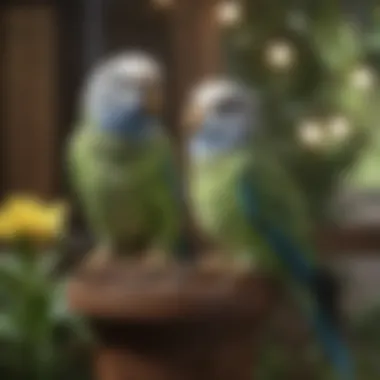
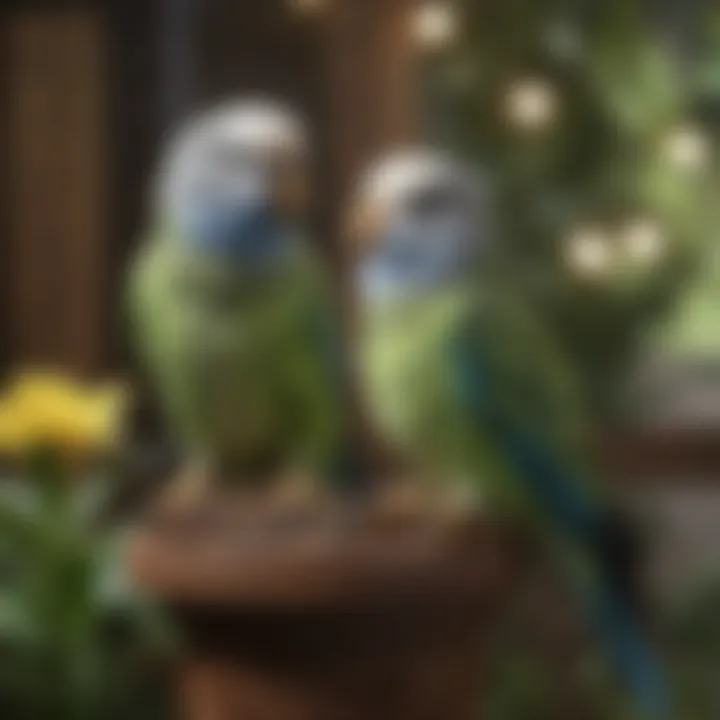
In summary, adapting enclosures to cater to the unique needs of elderly budgies and those with health conditions is essential. It not only promotes comfort but also contributes positively to their overall quality of life. Understanding the specific requirements enables bird owners to provide an environment where their pets can thrive.
Engagement with Budgies
Engaging with budgies is a crucial aspect of their care that impacts their overall well-being and happiness. This section highlights the elements and benefits of creating a connection with these vibrant birds. When budgies feel a bond with their owners, their ability to thrive in captivity increases significantly. This engagement fosters a sense of security and decreases stress, leading to a more enriched life.
Interactive Time Outside the Cage
Allowing budgies time outside their enclosure is essential for their physical and mental stimulation. It gives them a chance to explore their environment and engage in natural behaviors that might be limited while inside a cage. When budgies fly around in a safe, controlled area, they exercise their wings and exhibit playful actions, contributing positively to their health.
Key Benefits:
- Physical Exercise: Free flight promotes muscle development and coordination.
- Mental Stimulation: Exploring new spaces introduces varied stimuli that keep their minds active.
- Behavioral Expression: Being outside their cage allows them to exhibit natural behaviors, reducing boredom and stress.
It is essential to supervise budgies during this time to prevent accidents. Also, creating a safe area without hazards—like open windows or ceiling fans—is critical in ensuring their safety. Incorporating toys like swings or climbing structures can also encourage playfulness during this time.
Building Trust and Bonding
Building trust with budgies leads to stronger relationships between the birds and their owners. Budgies are social creatures, and they thrive on interaction. Establishing a routine that incorporates gentle handling, talking, and offering treats will gradually develop a bond.
Trust-Building Strategies:
- Consistent Interaction: Regular interaction helps them recognize their owners and feel comfortable.
- Positive Reinforcement: Use treats like millet to reward them for coming to you or performing desired actions.
- Gentle Handling: Always handle budgies calmly to prevent them from feeling threatened or anxious.
Trust takes time, but the reward is a friendly and affectionate companion. When a budgie feels safe, it will show its personality, leading to a fulfilling relationship.
"Birds have a natural inclination to form bonds. When we nurture this instinct, we foster a happier, healthier budgie."
Taking the time to engage with budgies in these ways enriches their lives and enhances the companionship experience for bird owners.
Common Mistakes to Avoid
Creating a suitable environment for budgies involves careful planning and attention to detail. Understanding common mistakes can greatly enhance the well-being of these birds. Avoiding such errors not only contributes to happier and healthier pets but also ensures a more rewarding experience for the owner. This segment highlights two significant pitfalls that caregivers frequently encounter.
Overcrowding the Enclosure
One of the most prevalent issues in budgie care is overcrowding. Many owners underestimate the space that multiple budgies require. When enclosures are cramped, birds tend to exhibit stress and aggressive behaviors. It is crucial to provide adequate room for each bird to move freely, exercise, and establish their territory.
- A general rule is to allow at least 12 inches of space in width and height per budgie.
- Social interactions can be beneficial, yet they must occur in a space that accommodates individual needs.
- Overcrowding can lead to poor feather condition and increased illness rates, as stress weakens the immune system.
To prevent overcrowding, assess the size of your enclosure based on the number of birds. If you are caring for multiple budgies, consider upgrading to a bigger aviary to meet their needs. A suitable environment not only fosters better behavior but also prolongs the lifespan of your pets.
Ignoring Temperature Fluctuations
Temperature control is vital yet often overlooked by budgie owners. Birds are sensitive to extreme temperature changes. Those kept in environments with significant fluctuations can struggle, affecting their overall health and behavior. The ideal temperature range for budgies is between 65°F and 75°F.
- Avoid placing enclosures near drafty windows or heating vents.
- Sudden changes in temperature, such as moving an enclosure from a warm room to a colder space, can induce stress.
- Monitoring room temperature and providing insulation during colder months is essential to create a stable environment.
Failure to address temperature issues can result in respiratory problems or lethargy. Using thermometers and making necessary adjustments will ensure a consistent, comfortable habitat for your budgies.
Recommended Products and Resources
When setting up budgie enclosures, selecting the right products and resources can significantly influence the well-being of these feathered companions. Budgies thrive in environments that cater to their physical and mental needs. Utilizing high-quality enclosures, toys, and feeding systems directly impacts their health and happiness. Thus, thorough research and familiarity with reputable brands become essential for any bird owner. Access to reliable information and products also empowers owners, helping them to avoid common pitfalls and misunderstandings in budgie care. This discussion aims to outline critical resources for both novice and experienced budgie enthusiasts.
Quality Brands for Budgie Enclosures
A variety of brands cater to the unique needs of budgies. Investing in established brands ensures safety and durability. Here are a few recommended brands that stand out:
- A&E Cage Company: Known for their innovative designs and strong materials. They offer various sizes, which accommodate different species of birds.
- Mcage: Provides affordable yet functional options for various aviary needs.
- Vision Bird Cages: Focuses on the bird's perspective, ensuring every product is practical and enriched for avian health.
- Kaytee: Famous for their comprehensive range of bird toys and treats, which keep budgies mentally stimulated.
These brands have earned a reputation for producing enclosures and accessories designed with the birds’ welfare in mind. Choosing products from reliable sources helps reduce risks associated with low-quality materials, such as toxic coatings or improper sizes. Always check user reviews and product specifications to find what works best for your situation.
Online Communities and Forums
Engaging with online communities provides invaluable support and knowledge sharing. These platforms can be a treasure trove of information and advice. Some prominent options include:
- Reddit: Subreddits focused on budgies and bird care often share tips about enclosure setups, care routines, and much more. It allows for real-time feedback on issues you'd like to address.
- Facebook Groups: Numerous groups cater to budgie owners where members share their experiences and photos of their setups. These communities encourage learning and collaboration among enthusiasts.
- Avian Forums: Dedicated avian forums often have sections specifically about budgie care. They are great places to ask questions and receive detailed answers from experienced bird owners.
Engaging with these communities not only helps owners gather diverse opinions but also fosters a sense of camaraderie within the bird-keeping community. Connecting with others enhances the experience of owning these birds, making it easier to learn and adapt as needed.
"The best way to keep budgies happy is to be informed and connected with a community of like-minded bird lovers."
The End
In summary, the conclusions drawn from this article emphasize the crucial role that proper budgie enclosures play in the overall well-being of these birds. The right habitat not only fulfills their physical needs, but also supports their psychological and social development. Visitors to this guide will appreciate the significance of selecting appropriate materials, ensuring ample space, and incorporating engaging features that encourage natural behaviors.
Recap of Key Points
- Budgies and their Enclosures: Understanding the importance of a well-designed habitat for the health of budgies.
- Space Requirements: Minimum space needed based on the number of birds.
- Material Choices: The types of materials that promote safety and durability.
- Enrichment Features: The importance of perches, toys, and food dispensers in creating a stimulating environment.
- Safety Measures: Ensuring that enclosures prevent escapes and protect birds from predators.
- Cleaning and Maintenance: Keeping the habitat clean is vital for the birds’ health.
- Adaptability for Different Needs: Adjusting enclosures for elderly or ailing budgies is essential.
Final Recommendations
- Choose the Right Size: Always opt for larger enclosures when possible, as budgies thrive in spacious environments.
- Select Safe Materials: Use non-toxic and durable materials, such as stainless steel or safe woods, to ensure the safety of your pets.
- Enrichment is Key: Regularly introduce new toys and rotate perches to maintain interest and encourage interaction.
- Routine Cleaning: Establish a cleaning schedule to keep the enclosure hygienic and free from harmful bacteria.
- Monitor Your Budgies: Pay attention to their behavior and adjust the enclosure as needed to meet their changing needs.
"A proper habitat is not just a cage; it's a nurturing environment that can significantly enhance the happiness of your budgies."
By adhering to these guidelines, bird owners can foster happier, healthier lives for their feathered companions, ultimately enriching their own experience as caregivers.















